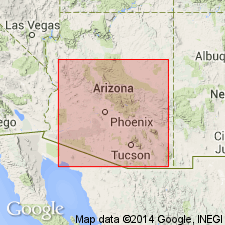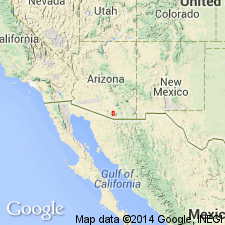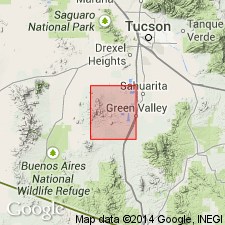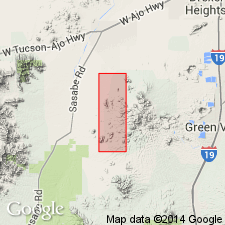
- Usage in publication:
-
- Ruby Star granodiorite
- Modifications:
-
- First used
- Geochronologic dating
- Dominant lithology:
-
- Granodiorite
- AAPG geologic province:
-
- Basin-and-Range province
Summary:
First use of the Ruby Star Granodiorite. Age is Tertiary based on radiometric (K-Ar) age of 59 Ma.
Source: GNU records (USGS DDS-6; Menlo GNULEX).

- Usage in publication:
-
- Ruby Star Granodiorite*
- Modifications:
-
- Named
- Dominant lithology:
-
- Granodiorite
- Quartz monzonite
- AAPG geologic province:
-
- Basin-and-Range province
Summary:
A large composite stock in the western part of the Pima mining district, Pima Co., AZ, Basin-and-Range province is formally named Ruby Star Granodiorite. [This name was shown on a table in a report by Livingston, Mauger, Damon, 1968, Economic Geology v. 63, p. 31, but was not defined by them in that report.] Type area designated in this report in parts of Ts 17 and 18 S, Rs 12 and 13 E. Was named for the Ruby Star Ranch. The granodiorite intrudes intensely deformed rocks of Precambrian to Late Cretaceous age; it is overlain by Quaternary alluvium. The stock consists of two granodiorite facies, and near some porphyry copper deposits, several quartz monzonite facies. Two facies shown on small geologic map. The equigranular, border-phase granodiorite is light-gray, medium-grained. The porphyritic core phase is like the border phase except that it has less biotite, more quartz and plagioclase, lacks hornblende, has 2-10 % phenocrysts of potassium feldspar. The quartz monzonitic part distinguishable by its mineral properties and finer grain; the aplitic phase is an intrusive body about 1,000 ft wide and 1,800 ft long. The quartz monzonite porphyry is gray, has phenocrysts of white plagioclase, gray quartz, pink potassium feldspar and biotite which make up about half of the rock. The aplitic quartz monzonite has a groundmass of quartz, orthoclase, oligoclase, and biotite in grains less than half a mm in diameter. The quartz monzonite porphyry has been dated as 56 m,y, (K-Ar method). Assigned to the Paleocene.
Source: GNU records (USGS DDS-6; Denver GNULEX).

- Usage in publication:
-
- Ruby Star Granodiorite*
- Modifications:
-
- Overview
- AAPG geologic province:
-
- Basin-and-Range province
Summary:
Mapped as a large body of granodiorite porphyry and quartz monzonite in northwest part of quad., Pima Co., AZ in the Basin-and-Range Province. Three isotopic dates of 58.7 m.y., 59 m.y., and 61.6 m.y. [Only the last date is new with this report.] Cross sections. Assigned to the Paleocene.
Source: GNU records (USGS DDS-6; Denver GNULEX).

- Usage in publication:
-
- Ruby Star Granodiorite*
- Modifications:
-
- Overview
- AAPG geologic province:
-
- Basin-and-Range province
Summary:
Mapped at east-central part of quad., Pima Co., AZ in the Basin-and-Range province. Described as a light-to-pale-brownish-gray, medium-grained, biotite granodiorite. Includes granodiorite porphyry and quartz monzonite. Relation to some dacitic rocks unknown. Of Paleocene age.
Source: GNU records (USGS DDS-6; Denver GNULEX).
For more information, please contact Nancy Stamm, Geologic Names Committee Secretary.
Asterisk (*) indicates published by U.S. Geological Survey authors.
"No current usage" (†) implies that a name has been abandoned or has fallen into disuse. Former usage and, if known, replacement name given in parentheses ( ).
Slash (/) indicates name conflicts with nomenclatural guidelines (CSN, 1933; ACSN, 1961, 1970; NACSN, 1983, 2005, 2021). May be explained within brackets ([ ]).

